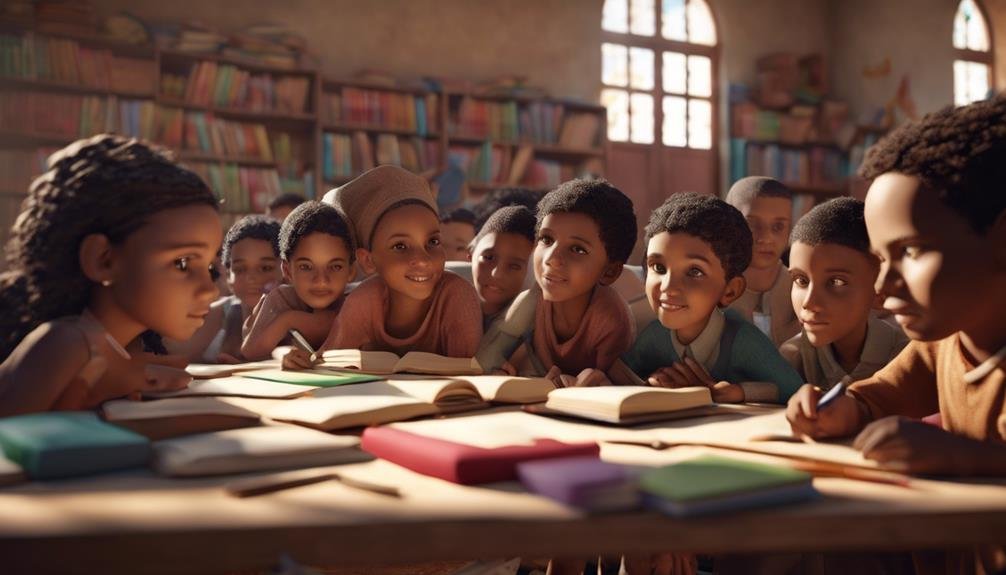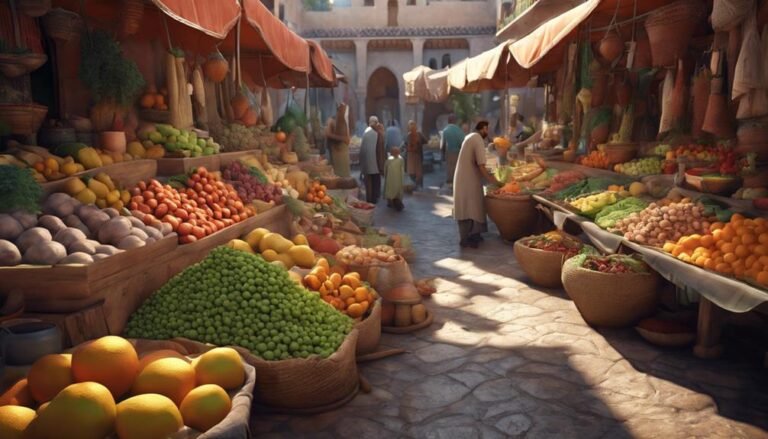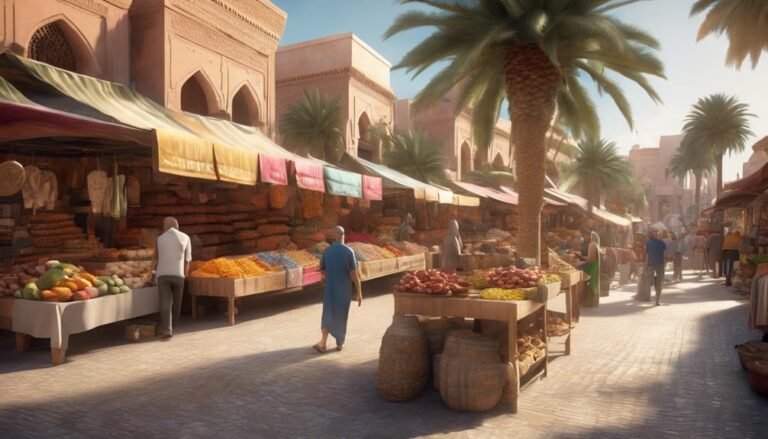In Morocco, literacy rates vary based on age, with younger generations having higher rates. Urban areas generally boast better literacy levels than rural areas, especially in tertiary education. Gender gaps persist, with men typically more literate, particularly in rural regions. Education plays an essential role in socio-economic development, impacting poverty rates. As the government focuses on improving literacy through various initiatives, challenges such as funding and cultural norms remain. The future outlook emphasizes technology integration, global partnerships, tailored programs, and data-driven strategies to enhance literacy nationwide. Discover more insights on Morocco's literacy landscape for a deeper understanding.
Key Takeaways
- Literacy rates in Morocco vary, with around 73% of the population considered literate.
- Disparities exist across regions, with urban areas generally exhibiting higher literacy rates.
- Efforts are ongoing to improve literacy, especially among older age groups and in rural areas.
- Female literacy rates lag behind male rates, prompting targeted interventions for improvement.
- Government initiatives focus on enhancing education quality and implementing literacy programs.
Historical Overview of Literacy in Morocco
Throughout the history of Morocco, literacy rates have been influenced by various socio-economic factors. Literacy initiatives and educational reforms have played a pivotal role in shaping the educational landscape of the country.
In the early 20th century, Morocco began to implement literacy programs aimed at improving access to education for its population. These initiatives were further bolstered by educational reforms that focused on expanding educational infrastructure and enhancing the quality of teaching.
Under French and Spanish colonial rule, efforts were made to introduce Western-style education systems, which had a significant impact on literacy rates in urban areas. However, rural areas faced challenges in accessing quality education due to limited resources and infrastructure. Despite these challenges, the literacy initiatives continued to evolve over the years, with a particular focus on enhancing female literacy rates.
Current Literacy Rates by Age Group
In examining the current literacy rates by age group in Morocco, data reveals significant disparities in educational attainment across different generations. The importance of literacy interventions becomes apparent when looking at the literacy skills of various age groups in the context of the digital age.
Recent statistics indicate that younger age groups, particularly those under 25, have higher literacy rates compared to older generations. This trend suggests that current literacy interventions are more effective in promoting literacy skills among the youth. However, there's still a considerable portion of the older population with lower literacy levels, highlighting the need for continued efforts to enhance literacy among older age groups.
In today's digital age, where technology plays a pivotal role in communication and information dissemination, possessing adequate literacy skills is more important than ever. Ensuring that individuals of all age groups have the necessary literacy skills to navigate and thrive in the digital world remains a critical objective for educational institutions and policymakers in Morocco.
Disparities in Urban and Rural Literacy
Amidst the landscape of literacy in Morocco, stark differences in literacy rates between urban and rural areas emerge as a significant focal point for educational analysis. Education accessibility and regional disparities play a pivotal role in shaping these discrepancies. Below is a data-driven comparison of literacy rates in urban and rural areas of Morocco:
| Education Level | Urban Areas (%) | Rural Areas (%) |
|---|---|---|
| Primary Education | 89% | 63% |
| Secondary Education | 72% | 38% |
| Tertiary Education | 45% | 16% |
| Literacy Rate (Overall) | 80% | 55% |
| Gender Disparities | Lower for females in rural areas |
The table illustrates that urban areas generally exhibit higher literacy rates across all education levels compared to rural areas. The disparities in tertiary education are particularly pronounced, highlighting the challenges rural regions face in providing advanced education opportunities. Addressing these regional disparities is vital in ensuring equal access to quality education for all individuals, regardless of their geographic location.
Gender Disparities in Literacy
When examining literacy rates in Morocco, it's essential to take into account the gender disparities that exist. Data shows variations between male and female literacy rates, underscoring the importance of a closer look at educational opportunities for women.
Cultural norms also play a significant role in shaping these disparities, influencing access to education and literacy levels among different genders.
Male Vs Female Literacy
Gender disparities in literacy rates reveal significant differences between male and female educational achievements in Morocco. While progress has been made in recent years, challenges persist in achieving gender equality in literacy.
Socio-economic factors play a pivotal role in shaping these disparities, with rural areas often experiencing wider gaps between male and female literacy rates compared to urban regions. According to data, male literacy rates in Morocco tend to be higher than those of females, indicating an ongoing need for targeted interventions to improve female literacy rates.
Efforts focused on enhancing educational opportunities for girls, addressing cultural norms, and providing resources in underserved communities are essential in narrowing the gender literacy gap in Morocco.
Educational Opportunities for Women
Women in Morocco face persistent challenges in accessing educational opportunities, particularly in narrowing the gender disparities in literacy rates. Despite progress in recent years, gender gaps still exist.
According to data, the literacy rate for females in Morocco is around 52%, notably lower than the rate for males at 78%. This disparity highlights the ongoing need for initiatives focused on women's empowerment and gender equality in education.
Improving educational opportunities for women not only enhances their individual prospects but also contributes to the overall development of society. By addressing these disparities and promoting equal access to education, Morocco can work towards a more inclusive and equitable society where both men and women have the same opportunities to thrive.
Impact of Cultural Norms
Facing persistent challenges in accessing educational opportunities, particularly in narrowing the gender disparities in literacy rates, Morocco's cultural norms play a significant role in shaping the educational landscape. Cultural barriers and societal influences have contributed to the existing gender gap in literacy rates. In Morocco, traditional gender roles often prioritize boys' education over girls', leading to lower literacy rates among women. This disparity highlights the need for targeted interventions to address cultural norms that hinder equal access to education. By challenging these deep-rooted beliefs and advocating for gender equality in education, Morocco can work towards a more inclusive and equitable society. The table below illustrates the current literacy rates in Morocco based on gender:
| Gender | Literacy Rate |
|---|---|
| Male | 79% |
| Female | 59% |
Impact of Literacy on Socio-Economic Development
Higher literacy rates in Morocco have a direct correlation with increased employment opportunities and a decrease in poverty levels.
The ability to read and write opens doors to various job prospects, consequently contributing to economic growth and stability.
As literacy rates improve, so does the overall socio-economic development of the country.
Literacy and Employment
The correlation between literacy rates and employment opportunities in Morocco is a pivotal aspect of socio-economic development. Higher literacy levels enable individuals to engage more effectively with technology, which is important in today's digital world.
Literacy and technology go hand in hand, as individuals with strong literacy skills are better equipped to adapt to technological advancements and access a wider range of job opportunities. Additionally, literacy plays a significant role in fostering entrepreneurship.
Individuals who are literate are more likely to have the necessary skills to start and manage their own businesses, contributing to economic growth and job creation. Investing in literacy programs not only enhances employment prospects but also stimulates entrepreneurial endeavors, ultimately driving socio-economic development in Morocco.
Literacy and Poverty
The relationship between literacy rates and poverty levels in Morocco reveals a crucial link between education and socio-economic well-being. Literacy interventions play a pivotal role in addressing poverty alleviation by equipping individuals with the necessary skills to secure better employment opportunities and higher incomes. According to data from the World Bank, countries with higher literacy rates tend to have lower poverty rates, demonstrating the significant impact of education on overall prosperity. Investing in literacy programs not only enhances individuals' abilities to access information and participate in the workforce but also contributes to the overall development of a nation. By prioritizing literacy, Morocco can take substantial steps towards reducing poverty and fostering sustainable socio-economic growth.
| Literacy Interventions | Impact on Poverty Alleviation | Importance |
|---|---|---|
| Education Programs | Increase employability and income levels | Empowers individuals |
| Adult Literacy Classes | Enhance skills for economic participation | Reduces dependency |
| Vocational Training | Align skills with job market needs | Boosts economic productivity |
Government Initiatives to Improve Literacy
To address the challenge of low literacy rates in Morocco, the government has implemented various initiatives aimed at improving literacy levels among the population. These government initiatives include the establishment of adult literacy programs targeted at individuals who didn't have the opportunity to attend school or complete their education. Additionally, the government has focused on enhancing primary and secondary education by providing additional resources and training for teachers to improve the quality of education received by students. Moreover, Morocco has implemented community-based literacy projects to reach remote and underserved areas, ensuring that a larger portion of the population has access to educational opportunities.
Through these government initiatives, Morocco has seen some improvements in literacy rates over the years. However, challenges such as access to quality education, socioeconomic factors, and cultural barriers still exist and continue to impact literacy levels in the country. Moving forward, it will be essential for the government to continue investing in literacy programs and education initiatives to further enhance literacy rates and empower its population.
Challenges to Enhancing Literacy Rates
Despite the government's efforts to improve literacy rates in Morocco, several challenges hinder progress in enhancing literacy levels among the population. When it comes to literacy programs, one of the main obstacles is the lack of funding. Insufficient financial resources restrict the expansion and effectiveness of literacy programs, limiting their reach and impact.
Additionally, the geographical distribution of these programs poses a challenge, with rural areas often having less access to educational resources compared to urban centers.
Community involvement is another critical aspect that faces challenges. While there are initiatives to engage local communities in promoting literacy, factors such as low awareness, cultural norms, and limited participation hinder the effectiveness of these efforts. Without active engagement and support from the community, the success of literacy programs is compromised.
Addressing these challenges requires a multi-faceted approach that involves increased funding for literacy programs, targeted efforts to reach underserved regions, and tailored strategies to boost community involvement. By overcoming these obstacles, Morocco can make significant strides in enhancing literacy rates and fostering a more educated society.
Future Outlook for Literacy in Morocco
Efforts to enhance literacy rates in Morocco face a pivotal juncture as the country looks towards shaping its future educational landscape. In order to improve literacy levels, several key strategies can be implemented:
- Technology integration: Incorporating technology into educational practices can enhance access to learning resources and improve overall literacy skills.
- Global partnerships: Collaborating with international organizations and other countries can bring in expertise, funding, and resources to support literacy initiatives.
- Literacy programs: Implementing targeted literacy programs tailored to different demographics can address specific challenges and improve overall literacy rates.
- Data-driven approach: Utilizing data to identify areas with low literacy rates and track the effectiveness of interventions can help in making informed decisions for future strategies.
- Teacher training: Providing professional development opportunities for educators can enhance teaching methods and ultimately contribute to improving literacy levels nationwide.
Conclusion
Looking at the literacy rates in Morocco, it's evident that there have been improvements over the years. However, disparities still exist between urban and rural areas, as well as between genders.
One striking statistic is that the overall literacy rate in Morocco stands at around 73%, with significant efforts being made by the government to increase this number.
It's essential for the country's socio-economic development to continue focusing on improving literacy rates for all.

The Editorial Team is a passionate group of Morocco enthusiasts dedicated to sharing the beauty, culture, and wonders of this captivating country. With diverse backgrounds and a deep love for travel, we strive to bring you engaging and informative content that inspires your Moroccan adventures. From uncovering hidden gems and sharing local insights to exploring mouthwatering cuisine and showcasing the vibrant lifestyle, our team is committed to providing you with valuable resources and exciting stories that enhance your exploration of Morocco. Join us on this journey as we celebrate the rich heritage and unforgettable experiences that make Morocco truly special.







